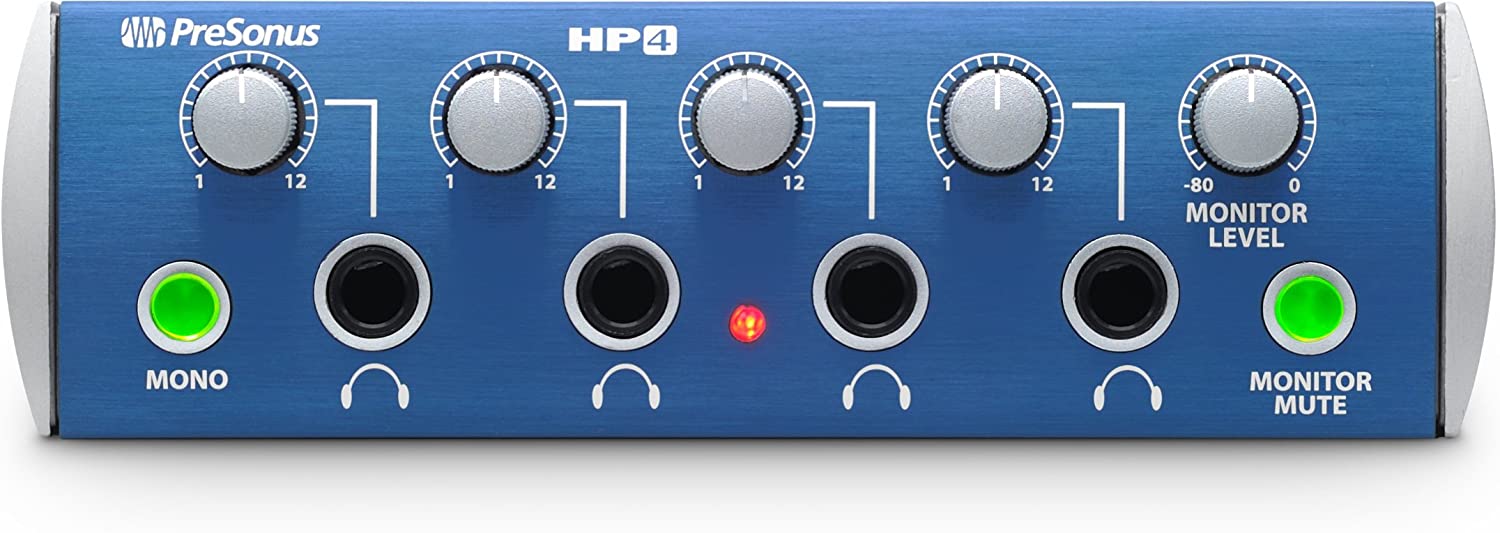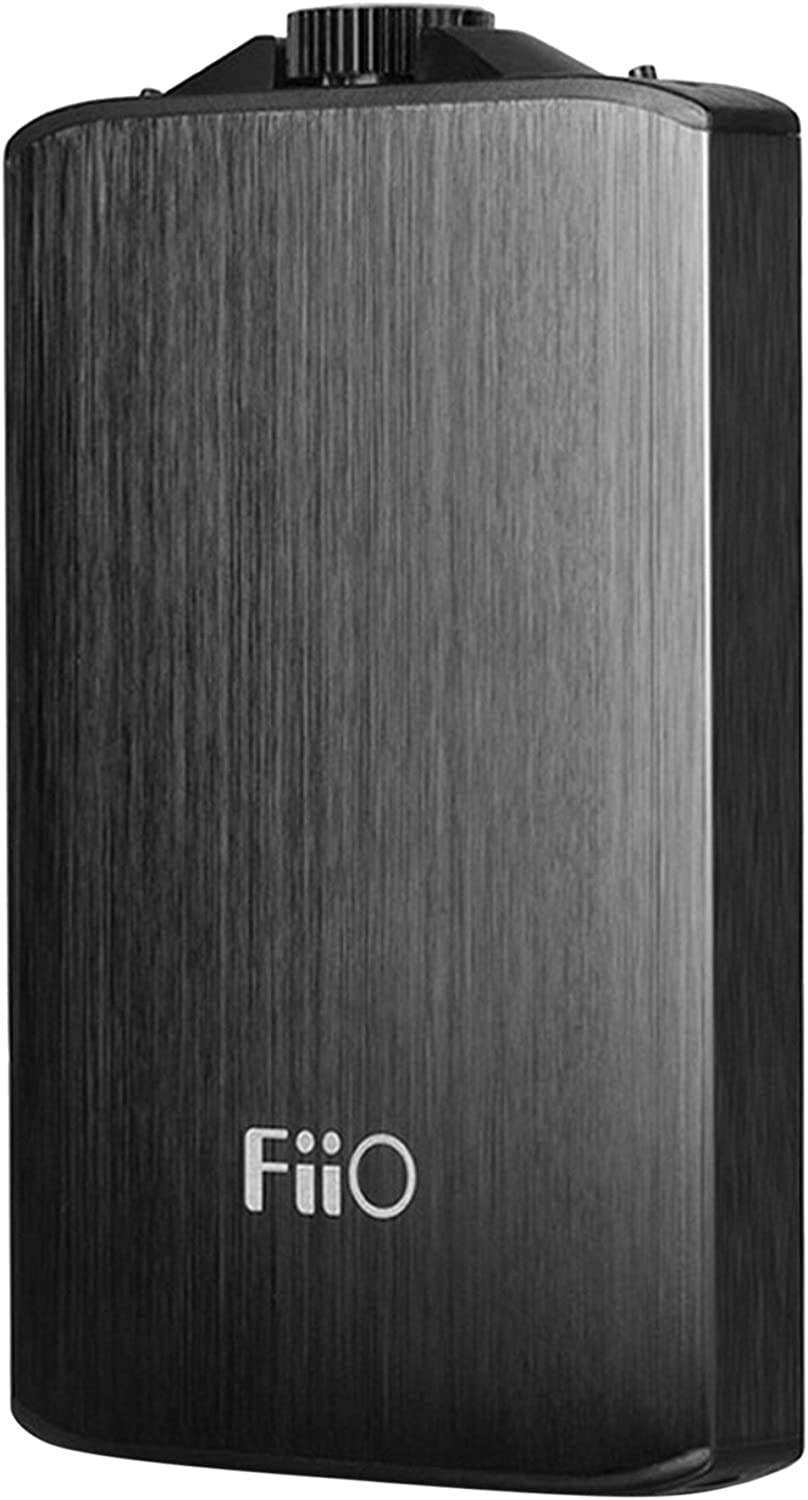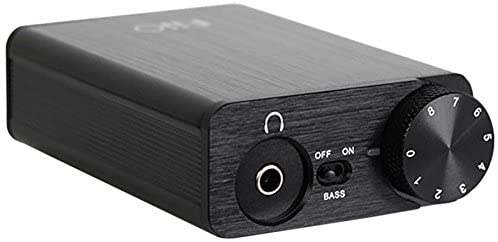
Best Budget

Editor's Pick

Thomas Boxtiger
Head Music Editor
A headphone amplifier takes your basic amplifier functionality and compresses it into a significantly more compact design. They come in various sizes, with some small enough to fit in your palm while others are as large as an old fashioned CD player. In this article, we'll discuss the types of amps, what to consider when buying one, and dig into the best headphone amplifiers available today.
1. Behringer Microamp HA400

One aspect of the Behringer Microamp HA400 that I like is how ultra-lightweight and compact this amplifier is. It is also quite flexible in that it can amplify and deliver 4 separate volume levels for 4 separate pairs of headphones at the same time while also delivering top-notch audio quality.
This ability for each individual headphone to control their volume is a great touch especially for studio use when doing a recording. The Behringer HA400 comes with 4 high-grade stereo amplifiers that can deliver consistent high-quality sound even when used at max volume. The amplifiers used by the Behringer is a compact version of amps used in heavy-duty audio systems without scaling back much of its performance.
Pros
- This headphone amp is one of the most compact and lightweight devices around.
- Affordable price considering the quality it can deliver.
- Durable and well-made.
Cons
- There is no on and off switch on the amp.
- Maximum volume is not as high as some would want.
2. Beyerdynamic A20 Headphone Amplifier

As these are made in Germany I believe it is safe to assume that it comes with top-notch quality craftsmanship. The A20 has a solid weight and feel, although it feels heavier than I expected at a little over 3.5 lbs. Just looking at this headphone amp will give you an idea that this one is a high-end device.
It features LED power button, two 6.35 mm headphone outputs and an ALPS potentiometer knob that feels fluid to turn. I did notice a slight decrease in volume once I plugged to headphone jacks but not a deal breaker. The A20 can power 2 headphones simultaneously while delivering an impedance of around 30 to 600 ohms. The output power is at 100 MW per 600 ohms, 150 MW per 30 ohms, and 170 MW per 250 ohms.
Pros
- High quality build.
- Helps improve sound quality considerably.
- Will work well with most headphones.
Cons
- Most of the advantages will be noticed most when paired with high-impedance headphones.
3. FiiO A3 Portable Headphone Amplifier

This new iteration of the FiiO E11K offers a sleeker and more portable design. It features 1/8” headphone jack outputs as well as an aux input. The A3 has a low/high gain and bass boost that is located at the front for quick and easy access. The amp used in the E11K has been upgraded to the OPA1642 op-amplifier with power output delivering more as well. It uses 1400mAH rechargeable batteries that allows the amp to operate for up to 16 hours.
Pros
- Portable and lightweight.
- User-friendly controls.
- Rechargeable battery allows this amp to operate for up to 16 hours at full capacity.
- Affordable price tag.
- Delivers great quality sound and is compatible with various devices.
Cons
- Sometimes, there is a slight hissing sound when charging with some IEMs.
- There are no user-replaceable battery options available.
4. FiiO E10K USB DAC and Headphone Amplifier

This is a great choice for those looking for a headphone amp and DAC combo at an affordable price. This amp DAC combo offers solid separation in terms of multiple headphone jack use. The FiiO can deliver pretty high-volume levels without impeding the sound quality. The compact design of the E10K makes it ideal for outdoor uses. I actually recommend this one as an entry-level headphone amp as it quite affordable and offers a well-rounded experience.
Pros
- Small and compact.
- Versatile and compatible with most headphones.
- Solid DAC quality performance.
- Aluminum casing and metal connectors are built well.
Cons
- Headphone plugs are not muted when lined out.
5. PreSonus HP4 4-Channel Compact Headphone Amplifier

The PreSonus HP4 Amplifier allows 4 separate headphones to control their own volume levels. It features 150mw amplification for each channel and -98db noise floor. The amp comes with a volume knob that allows users to control room monitors. You can use it either mono or stereo inputs and is powered via external mounted supply. This one is desktop size so it might not be a good choice for people who will be always on the go.
Pros
- Can deliver good bass sounds.
- Significantly quieter.
- User-friendly and quick setup.
- 4 independent volume controls plus the monitor mute button.
Cons
- Can have ambient noise issues.
2022 Buying Guide
Introduction
What is a headphone amplifier? Do you even need one? Well, for audiophiles such as me the answer is a resounding "yes!" Check out the video below for some reason why a headphone amp is a worthwhile investment:
Nowadays, most people tend to get their music fix through their mobile devices. For those of you who have access to an actual audio system at home, you will know that there is the considerable difference in the audio quality delivered via your smartphones. This is, of course, the lack of power to produce the best possible audio quality. While most mobile devices have a built-in amp, these are noticeably insufficient when it comes to delivering satisfying audio quality. By using a headphone amplifier, you will be able to give your portable headphone experience that much needed a boost.
The more expensive headphone amps can power 4 headphones at the same time. There are also headphone amps that come with USB ports for file transfers and streaming. The biggest advantage of using a headphone amp is similar to the reason why you buy an amplifier for your stereo; it gives you the ability to make precise adjustments to the audio to suit your listening needs. Of course, it delivers that in a more compact and portable form.
When you go out to your local electronics store, you will most likely come across solid-state amplifiers as these are the most common in terms of headphone amps. This headphone amp features a digital to analog converter and can deliver crystal clear quality audio.
Different Types
Headphone amplifiers are used primarily on headphones instead of speakers. There are a variety of headphone amps on the market, each with their own sizes, designs, and specifications. Some refer to standard compact speakers as headphone amplifiers, but since they replace your headphones when listening to music they're not true headphone amps.
Headphone amps are used in conjunction with your audio system and include a jack to connect your headphone to. As stated earlier, some mobile audio devices already come with a built-in headphone amp but if you wish to get the best possible performance and quality, I suggest you go for the standalone amps instead.
Each headphone amps will also deliver different audio quality, power output, impedance, and other factors. When it comes to choosing a headphone amp there is one major tip I can give you, narrow it down to manufacturers known for their impressive audio system products. These brands might be more expensive but with a solid reputation with millions of consumers, you are guaranteed a high-quality product. You can check around forums for audiophiles for recommendations.
Think about selecting a headphone amp as picking the right motor for your vehicle. You will need to consider the most compatible motor to a specific car frame. That is basically the same when choosing an amplifier. You will need to make sure that the damping factor of the amp is relative to the audio device.
A different approach when choosing a headphone amp is by checking the sound manipulation features they offer. An example of this is by checking to see how good its cross-feeding feature is. Cross-feeding is the amps ability to combine two audio tracks seamlessly, thus eliminating issues of substantial channel separation. Cross-feeding is a headphone amp feature that I suggest you look for.
One of the most popular types of headphone amp today is the pro-audio style amp. This type of headphone amp also allows streaming of audio from or to several sources. It also comes with a nifty feature called sub-mixing. Sub-mixing is an amp’s ability to improve the audio quality delivered from several sources. It can also handle digital distribution impeccably well which is a great feature to have with today’s headphone amps.
What to Look For
Now that you have a grasp on the importance of having a headphone amp, which is better sound quality, it is time for you to learn the important factors to look for when buying one. Know that most headphones that are available on the market today are not optimized for best audio quality. It will not be able to deliver those musical nuances that will give you the most crisp and clear audio quality as it cannot deliver enough power to do so. By having a headphone amp, you will be able to take a significant amount of that pressure off of your default sound system.
Here are some key factors that you need to look for when choosing a headphone amplifier.
Headphone Impedance
Also known as “ohm” that can be seen in the product information or description. A rule of thumb is if the impedance rating is below 100 then you can do without an amplifier. If your headphone has an ohm rating above 100 then an amp is essential if you wish to have the best quality sound.
Headphone Sensitivity
Most headphone audio quality will see a significant drop in audio quality when the volume is turned up. Check what your headphone sensitivity rating is. If it is below 100 decibels (dB) at 1 milliwatt (MW) power, a headphone amplifier will be able to sort out those pesky drops in sound quality.
Size of the Amplifier
Basically, if you will be using it mostly at home then go for a desktop amplifier. If you will be going out a lot then pick a portable amplifier. Portable amplifiers might be more expensive but since you can use on the go and with a desktop, I believe that is a smart investment in the long run.
Conclusion
Hopefully, this article helped you figure out the best headphone amplifier to suit your needs. Remember that not all headphone amps are created equal and there will always be one specific type out there that will fit your style better than others. Don’t settle for just anything on the market and always arm yourself with the right information before making a purchase.
